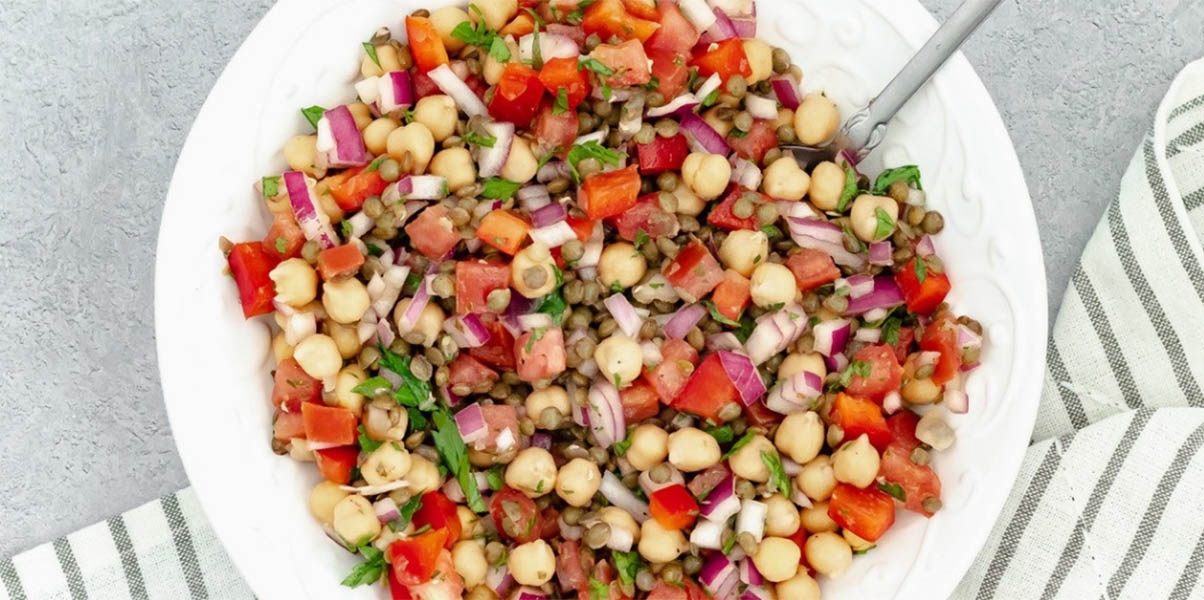
Yes, you can eat well on a budget.
ABOVE: This chickpea lentil salad combines whole grains and legumes, providing your body with the same nutrients as meat. (Photo: susanalsembach.com)
With the price of food rising, it is important to know that there are ways to make food work for us, even on a budget. So, this week, I will look at three ways you can make your food go further without spending more money. Not only will this make your grocery bill more bearable, but you will be eating better and having more energy, so why not give it a try?
Instead of cooking your vegetables as a side or enjoying them in a salad, many vegetables, such as carrots, beetroot, zucchini, spinach, kale, and more, can easily be made into a vegetable sauce by simply cooking them with a little water and salt, maybe adding some spices. Once cooked, they can be blended using a food processor with some of the cooking water to maintain the nutrients and then frozen.
After defrosting, you can easily make the pureed vegetables a little thicker by adding some cream and grated cheese. You then have a quick and tasty vegetable sauce that can be used with meats or pasta. In many grocery stores, you can find racks or shelves of vegetables that are still good but may not be as fresh as those in the main display areas. These vegetables are often discounted to a couple of dollars for a large quantity, for which you usually pay double, if not triple, the price. So, why not pick up that pack of beetroot or carrot and make the most of them?
Legumes are also a great food item to keep in your pantry. They provide quick and easy meals that are far more nutritious and less costly than pre-prepared or takeout meals. Legumes (beans, soybeans, chickpeas, lentils) can be a daunting food to cook at first, so if you are new to cooking with them, I recommend starting with canned. Legumes are a great source of fiber and provide long-lasting energy that helps to carry you through the day. By simply adding some chopped vegetables to a can of mixed beans, which you can top with some grated or diced cheese and a little olive oil, you have a tasty meal ready in under 10 minutes.
Batch cooking is a great option when working with dry legumes. Instead of preparing the amount needed for specific recipes, cook the whole bag and freeze any leftovers. Once defrosted, you can use the legumes alongside some meat, adding some chopped spinach for another easy meal. They are so versatile, which is why they are a good food to keep in your pantry.
Planning meals for the week can be tiring; however, focusing on two or three specific vegetables can simplify the process. For example, take a cabbage and a bag of carrots: you can eat them as a salad to accompany some chicken or fish; another evening, they could be used in a stir fry with shrimp and rice, and the third night they can be used in a soup, where simply adding some legumes, will make this into a tasty and satisfying meal. This approach will take the stress out of grocery shopping and meal prepping while reducing the cost of your groceries.
If you are concerned about protein intake, there is always the option of combining whole grains and legumes, therefore providing your body with the same nutrients you would receive if you were to eat meat. Why not start by trying this simple lentil chickpea salad recipe and let me know what you think?
Susan Alsembach is a nurse and registered holistic nutritionist. For more information about the services she provides, visit her website susanalsembach.com









